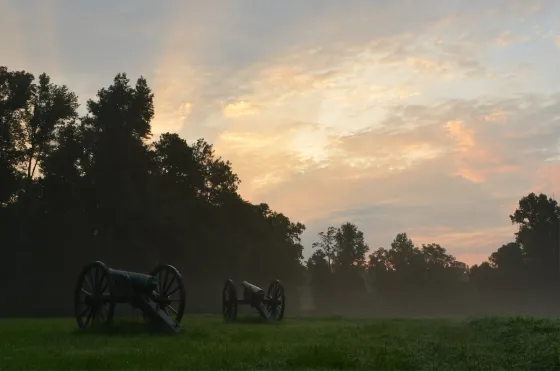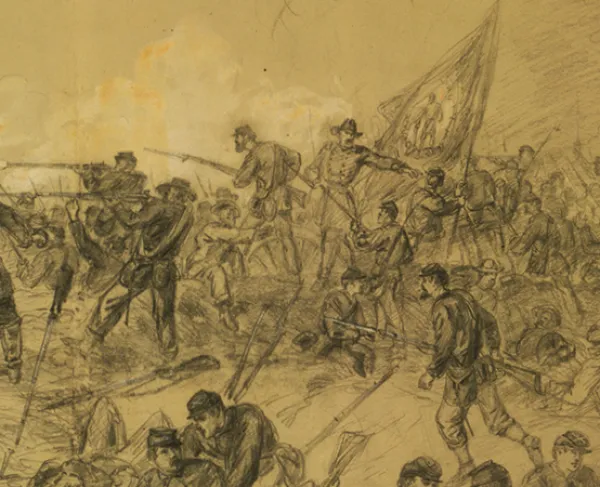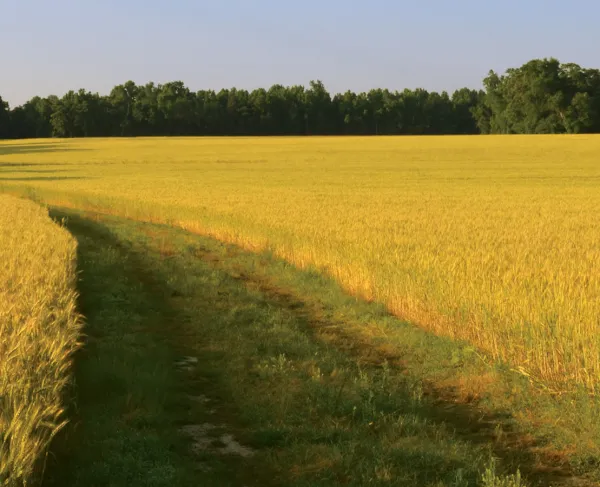American Battlefield Trust Launches Five-Year Push to Protect the Heart of Two Major Battlefields
(Richmond, Va.) – For decades, preservationists and historians have held a near-consensus view: A square-mile of the Richmond suburbs was the most historically significant but unprotected Civil War landscape in America. Not only was this land central to the Battle of Gaines’ Mill in June 1862, but two years later played a major role in the Battle of Cold Harbor. Even as other important battlegrounds around the former Confederate capital were protected and brought into Richmond National Battlefield Park through public-private partnerships, it remained pristine but vulnerable to the forces of development. But at the conclusion of a five-year campaign, launched today by the American Battlefield Trust, it will be protected forever.

“For the entirety of my nearly 21 years at the Trust, this land has stood at the pinnacle of our preservation hopes,” said organization President David Duncan. “This twice-hallowed ground will stand forever as a testament to the power of historic landscapes to inform our understanding and appreciation of the past.”
The full initiative involves several tracts to be announced in phases over the course of five years. Although confidentiality agreements prevent us from disclosing the campaign’s ultimate price from the outset, this massive project will be among the most ambitious ever undertaken by the Trust. While the entire effort is known as the “Gaines’ Mill – Cold Harbor Saved Forever Campaign,” the first stage is summarized as “Pickett’s Charge, Five Times as Large.” It includes a large, 96-acre parcel, plus 12 additional acres nearby — all of it land across which, between the two battles, some 70,000 soldiers charged. The total cost to preserve the 108 acres is $1,411,000. But, thanks to early gifts from major donors and a significant grant from the Lee-Jackson Educational Foundation, $511,000 remains to be raised. This is in addition to a separate project nearby, where the Trust is seeking $201,000 to protect 36 acres at Cold Harbor, including the site of the original Cold Harbor Tavern that lent its name to the fighting, and Trevilian Station, Va.
Protection of important battlefield landscapes around Richmond has always been driven by public-private partnerships. Initial efforts in the 1920s were led by Richmond newspaperman and Pulitzer Prize-winning historian Douglas Southall Freeman, whose Battlefield Markers Association erected 59 large interpretive tablets, many of which can still be seen around the region. Later, the Richmond Battlefield Parks Corporation acquired 572 acres that were deeded to the Commonwealth of Virginia in 1932 and became the first state park. Following considerable work by the Civilian Conservation Corps to connect the disparate sites from 1933–1941, Richmond National Battlefield Park was officially established in 1944.

As the decades passed, the city of Richmond grew swiftly, and the threat of development loomed ever larger. This resulted in the loss of important battlefields, such as Seven Pines, much of which is the site of the Richmond International Airport. Eventually, the Gaines’ Mill – Cold Harbor battlefield became one of the largest undeveloped areas in desirable Hanover County. However so great was the land’s historical significance that during a 2005 Trust Board Meeting, legendary historian Ed Bearss declared: “Even if you have to sell every other piece of battlefield land the Trust has ever saved in order to preserve this land, you should do it.” Trust officials were able to convey to Bearss that, after another 15 years of cultivation and negotiation, an agreement had been reached shortly before his passing in September at the age of 97.
This multi-year effort will contribute toward the protection of a critical mass at both battlefields — allowing visitors 200 years from now to understand how the action unfolded on that landscape. Such an achievement will be largely due to the Trust’s efforts — as recently as 2012, the National Park Service owned only 65 acres at Gaines’ Mill, a figure that quintupled with a single Trust transaction that year. More broadly, between 1995 and 2013, Richmond National Battlefield Park more than tripled in size, a feat made possible through the Trust’s efforts to protect these hallowed grounds and, when possible, transfer privately protected lands into the park. These efforts have been regularly supported by land acquisition funding from the National Park Service and matching grants from the American Battlefield Protection Program and Virginia Battlefield Preservation Fund, leveraged with donations from private citizens around the country.
As the capital of the Confederacy, Richmond’s capture was a chief war aim of Union armies during the Civil War. In the spring of 1862, Federal troops embarked from Fortress Monroe on the tip of the Virginia Peninsula and traveled northwest toward their goal. Maj. Gen. George McClellan’s troops made it practically to the gates of Richmond before stern resistance from Confederate Gen. Robert E. Lee, newly appointed to lead the Army of Northern Virginia, stymied the advance. On June 27, 1862, the armies clashed at the Battle of Gaines’ Mill – the third of the Seven Days’ Battles; the day’s final and successful assault remains the largest attack ever made on American soil. Two years later, the armies returned to the same spot for the final engagement of the Overland Campaign, the Battle of Cold Harbor. Union Lt. Gen. Ulysses Grant also launched one of the larger attacks of the Civil War across this ground on June 3, 1864. Regretful of the resulting bloody repulse and unable to capture Richmond, Grant turned to besiege the vital rail hub at Petersburg, preventing supplies from reaching Richmond.
Learn more about the Gaines’ Mill – Cold Harbor Saved Forever Campaign at www.battlefields.org/GMCH2020.
The American Battlefield Trust is dedicated to preserving America’s hallowed battlegrounds and educating the public about what happened there and why it matters today. The nonprofit, nonpartisan organization has protected more than 53,000 acres associated with the Revolutionary War, War of 1812, and Civil War. Learn more at www.battlefields.org.
###





